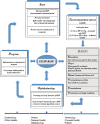How to prevent ROP in preterm infants in Indonesia?
- PMID: 33490635
- PMCID: PMC7813016
- DOI: 10.1002/hsr2.219
How to prevent ROP in preterm infants in Indonesia?
Abstract
Background and aims: Retinopathy of prematurity (ROP) is a severe disease in preterm infants. It is seen more frequently in Low-Middle Income Countries (LMIC) like Indonesia compared to High-Income Countries (HIC). Risk factors for ROP development are -extreme- preterm birth, use of oxygen, neonatal infections, respiratory problems, inadequate nutrition, and blood and exchange transfusions. In this paper, we give an overview of steps that can be taken in LMIC to prevent ROP and provide guidelines for screening and treating ROP.
Methods: Based on the literature search and data obtained by us in Indonesia's studies, we propose guidelines for the prevention, screening, and treatment of ROP in preterm infants in LMIC.
Results: Prevention of ROP starts before birth with preventing preterm labor, transferring a mother who might deliver <32 weeks to a perinatal center and giving corticosteroids to mothers that might deliver <34 weeks. Newborn resuscitation must be done using room air or, in the case of very preterm infants (<29-32 weeks) by using 30% oxygen. Respiratory problems must be prevented by starting continuous positive airway pressure (CPAP) in all preterm infants <32 weeks and in case of respiratory problems in more mature infants. If needed, the surfactant should be given in a minimally invasive manner, as ROP's lower incidence was found using this technique. The use of oxygen must be strictly regulated with a saturation monitor of 91-95%. Infections must be prevented as much as possible. Both oral and parenteral nutrition should be started in all preterm infants on day one of life with preferably mothers' milk. Blood transfusions can be prevented by reducing the amount of blood needed for laboratory analysis.
Discussion: Preterm babies should be born in facilities able to care for them optimally. The use of oxygen must be strictly regulated. ROP screening is mandatory in infants born <34 weeks, and infants who received supplemental oxygen for a prolonged period. In case of progression of ROP, immediate mandatory treatment is required.
Conclusion: Concerted action is needed to reduce the incidence of ROP in LMIC. "STOP - R1O2P3" is an acronym that can help implement standard practices in all neonatal intensive care units in LMIC to prevent development and progression.
Keywords: ROP; low‐middle income countries; predisposing factors; recommendation; screening.
© 2021 The Authors. Health Science Reports published by Wiley Periodicals LLC.
Conflict of interest statement
The authors have no conflict of interest to declare.
Figures



References
-
- Siswanto JE, Sauer PJ. Retinopathy of prematurity in Indonesia: incidence and risk factors. J Neonatal Perinatal Med. 2017;10:85‐90. - PubMed
-
- Siswanto JE, Widodo NH, Sauer PJJ. Eleven years of retinopathy of prematurity in one neonatal intensive care unit in Jakarta, Indonesia. Arch Dis Child. 2018;103:619‐621. - PubMed
Publication types
LinkOut - more resources
Full Text Sources
Other Literature Sources

